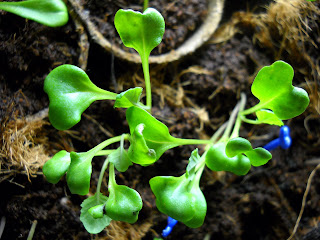
Today I decided it was time to "thin" my plants.
When planting from seed, gardeners often oversow, because the germination rate may be too low to guarantee we get as many plants as we want. One way to oversow is to plant multiple seeds in one container. In the case of my squashes, I planted two seeds per cell, and for every plant I needed, I made an extra cell.
As it turns out, two healthy zucchini grew out of one cell, and none out of any other cells. So I picked the weaker-looking one, and took it out of the cell and planted it back in another cell. (We take the weaker one, just in case it doesn't survive the transplant; the stronger plant will benefit from the weaker plant being removed).

I decided to use coir as the growing medium, because it provides better ventilation, which is more important at this stage than any other stage. (However, potting soil does provide more nutrients, which seedling will also need!)
Canadian Tire had a sale on Coco Peat, so I bought a bunch for the raised beds and as potting mix. I've got so much left over, it's so great!
I also decided to thin my Basils and Tomatoes (Stupice).
For those, I picked the weakest-looking plants by the cotyledons or by the stem very close to the roots, and just picked them out of the soil. With the tomatoes, I would have to dig a little to minimise root damage; but tomatoes have the awesome property of being able to grow roots from any part of the stem, when exposed to the right conditions of course.

Plants thinned/transplanted:
- Zucchini
- Butternut
- Purple Basils from Fibre tray
- Genovese Basils from Fibre tray
New seeds sewn:
- Snap peas (2 seeds per cell, 2 cells)
- Pumpkin (2 seeds per cell, 1 cell)
Zucchini before separation:
After separation:

After thinning some basils and tomatoes, I now have this arrangement:

New Growth! Snow peas are germinating!



Cosmos - Candy Stripe

Broccoli:



Tomatoes:



Butternut:

Pumpkin: one disfigured (mould??) cotyledon! Oh noes!

Looky that huge Zucchini true leaf! Makes me proud *sniffle*

Cosmos - Early Sensation Mix is very lanky, about 10cm or more!

Agastache Cana:

Marigold

That Aster I turned right-side up? It's still right-side up!

Bee Balm

Chamomile! The leaves are so distinct!

Tarragon seedlings--also have distinct leaves!

Sage

Purple Basil - some of it's going green for some reason!

Basil plants!

Parsley!

Basil - Genovese


Oregano!



















































